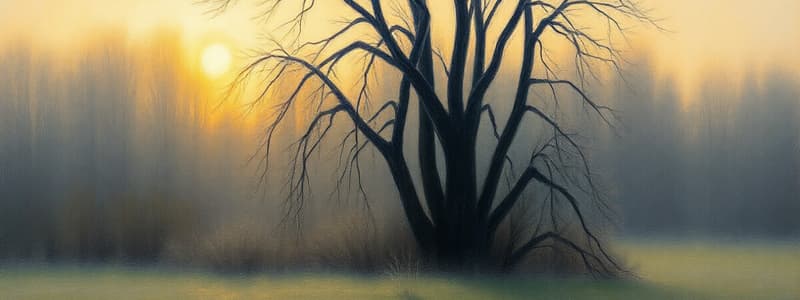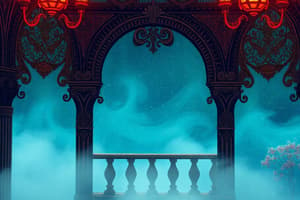Podcast
Questions and Answers
While observing frost and frozen dew, a student notices differences in their appearance. Which of the following statements accurately describes a key visual distinction between frost and frozen dew, as described in the text?
While observing frost and frozen dew, a student notices differences in their appearance. Which of the following statements accurately describes a key visual distinction between frost and frozen dew, as described in the text?
- Frost appears darker and more solid, while frozen dew is lighter and crystalline.
- Frost and frozen dew are visually indistinguishable, both appearing as solid, white layers.
- Frost appears whiter and crystalline due to ice crystals, whereas frozen dew is less white and more solid. (correct)
- Frost appears whiter and crystalline due to ice crystals, whereas frozen dew is more transparent and solid.
Fog formation requires water vapor to condense in the air. What crucial component in the atmosphere acts as the surface upon which water vapor condenses to initiate fog formation?
Fog formation requires water vapor to condense in the air. What crucial component in the atmosphere acts as the surface upon which water vapor condenses to initiate fog formation?
- Oxygen molecules
- Carbon dioxide
- Condensation nuclei (correct)
- Nitrogen gas
Which of the following conditions is essential for the formation of radiation fog?
Which of the following conditions is essential for the formation of radiation fog?
- Warm air moving over a cold surface during windy conditions.
- Mixing of two unsaturated air masses with different temperatures.
- Moist air being forced upwards along mountain slopes.
- Cool, clear nights allowing the Earth's surface to cool and saturate the air above. (correct)
Advection fog and radiation fog both involve air cooling to saturation, but they differ in their formation mechanisms. What is the primary distinction in how advection fog forms compared to radiation fog?
Advection fog and radiation fog both involve air cooling to saturation, but they differ in their formation mechanisms. What is the primary distinction in how advection fog forms compared to radiation fog?
Upslope fog is commonly observed in mountainous regions. Which of the following best describes the process that leads to the formation of upslope fog?
Upslope fog is commonly observed in mountainous regions. Which of the following best describes the process that leads to the formation of upslope fog?
Ice fog is a unique type of fog primarily found in polar regions. What is the key characteristic that distinguishes ice fog from other types of fog, such as radiation or advection fog?
Ice fog is a unique type of fog primarily found in polar regions. What is the key characteristic that distinguishes ice fog from other types of fog, such as radiation or advection fog?
Mixing fog, also known as evaporation fog, involves the interaction of two air masses. In the example of steam fog over a hot spring, what are the roles of the cold air and warm water in the formation of this type of fog?
Mixing fog, also known as evaporation fog, involves the interaction of two air masses. In the example of steam fog over a hot spring, what are the roles of the cold air and warm water in the formation of this type of fog?
Why does condensation form on the outside of a cold glass of iced tea on a warm day?
Why does condensation form on the outside of a cold glass of iced tea on a warm day?
What condition must be met in order for dew to form?
What condition must be met in order for dew to form?
On a cold morning, you notice frost on the ground. What process caused the frost to form?
On a cold morning, you notice frost on the ground. What process caused the frost to form?
What is the relationship between air temperature and the amount of water vapor it can 'hold' before becoming saturated?
What is the relationship between air temperature and the amount of water vapor it can 'hold' before becoming saturated?
Besides being below freezing temperatures, what process must occur for frost to form instead of frozen dew?
Besides being below freezing temperatures, what process must occur for frost to form instead of frozen dew?
At what point does air become saturated?
At what point does air become saturated?
Imagine you wake up one morning and notice ice crystals on your car windshield. The temperature is below freezing. What is the most likely explanation for this phenomenon?
Imagine you wake up one morning and notice ice crystals on your car windshield. The temperature is below freezing. What is the most likely explanation for this phenomenon?
Which of the following scenarios would result in the least amount of condensation?
Which of the following scenarios would result in the least amount of condensation?
Flashcards
Condensation
Condensation
The phase change from water vapor (gas) to liquid water.
Dew
Dew
Water vapor from the air that condenses into water droplets on cool surfaces.
Dew Point Temperature
Dew Point Temperature
The temperature at which air becomes saturated and condensation begins.
Saturated Air
Saturated Air
Signup and view all the flashcards
Air Temperature and Water Vapor
Air Temperature and Water Vapor
Signup and view all the flashcards
Deposition
Deposition
Signup and view all the flashcards
Frost
Frost
Signup and view all the flashcards
Frozen Dew vs. Frost
Frozen Dew vs. Frost
Signup and view all the flashcards
Frost Formation
Frost Formation
Signup and view all the flashcards
Frozen Dew
Frozen Dew
Signup and view all the flashcards
Fog
Fog
Signup and view all the flashcards
Radiation Fog
Radiation Fog
Signup and view all the flashcards
Advection Fog
Advection Fog
Signup and view all the flashcards
Upslope Fog
Upslope Fog
Signup and view all the flashcards
Ice Fog
Ice Fog
Signup and view all the flashcards
Study Notes
- Condensation is a phase change where water vapor turns into liquid water.
- Water droplets form on a cold iced tea glass through condensation of water vapor in the air.
Types of Condensation
- Dew is a type of condensation formed when the temperature drops below the dew point temperature.
- The dew point temperature is when air becomes saturated and can no longer hold water vapor molecules.
- Warmer air can hold more water vapor than cooler air without becoming saturated
- Dew is water vapor from the atmosphere condensing into droplets on cool surfaces.
- Frost forms when dew freezes or when water vapor goes directly to a solid (deposition) in below-freezing conditions.
- Frost appears whiter with ice crystals, while frozen dew is more solid and not as white.
- Fog is a cloud close to the Earth's surface.
- Fog forms when water vapor condenses on condensation nuclei (tiny particles like dust, pollen, salt, ash, or bacteria) in the air.
Types of Fog
- Radiation fog forms on cool, clear nights when the Earth's surface cools, causing the air near the surface to condense.
- Advection fog occurs when warm air moves across a cooler surface (ground, snow, ice, or water).
- It can last for days, occur in windy conditions, and when clouds are present.
- It can be seen along the California coastline.
- Upslope fog forms when moist air is pushed up a hill or mountain by wind.
- Common in the Rocky Mountains.
- Ice fog forms in polar regions when water vapor freezes into ice crystals.
- Common the interior of Alaska in winter months.
- Mixing fog (evaporation fog) occurs when two unsaturated air parcels mix to create a saturated air mass.
- Steam fog, seen near hot springs, is a type of mixing fog formed when cold air moves over warm water.
Studying That Suits You
Use AI to generate personalized quizzes and flashcards to suit your learning preferences.




